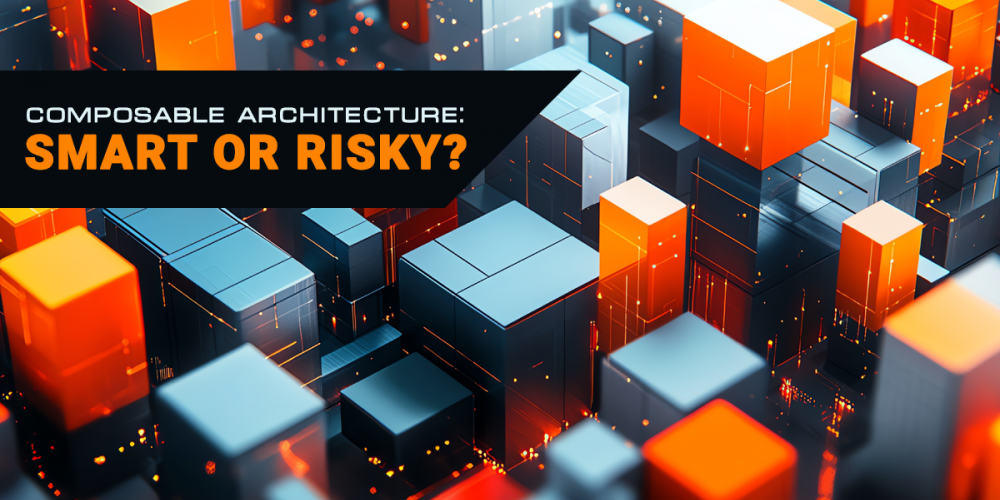
Composable Architecture: A Smart Choice—or Risky Gambit?
Composable architecture—a modular, API-first model built from discrete, interchangeable services—is rapidly gaining traction. We’ve written about it in the past, but Gartner predicts that 70% of large and midsize organizations will consider composability a key success criterion, and it may accelerate feature delivery by up to 80% (Newstack.io). However, as with any architectural paradigm, it comes with trade-offs.
Advantages
- Faster Time to Market & Agility
Organizations using composable systems launch new features up to 80% faster, driven by reusable components and decoupled delivery cycles (LinkedIn).
- Lower Total Cost of Ownership (TCO)
By assembling best-of-breed modules, companies avoid monolithic lock-in, reduce license fees, and pay only for needed services (craftercms.com).
- Modularity and Scalability
Independent services can scale individually, speeding updates and minimizing the blast radius of failures and improving security.
- Resilience & Fault Isolation
A failure in one module doesn’t cripple the entire system—enhancing operational stability and reliability.
- Improved ROI
According to Contentstack, enterprises can achieve 295% ROI over three years, thanks to faster delivery and reduced overhead Contentstack.
Custom Software vs. Legacy Migration
Custom/New Software
When building new applications from scratch:
- Clean Domain Modeling
Start with good domain design and deploy modular, bounded-context services—minimizing technical debt from day one.
- Team Autonomy
Teams can choose ideal technology per module (e.g. Go for performance-critical services, Node.js for APIs, Python for analytics).
- API-First Delivery
Frontend, backend, mobile, IoT adapters can be developed in parallel, connected through consistent APIs.
- Financial Benefits:
- Up to 48% productivity gains
- 37% reduction in development costs
- 80% faster release cycles
Risks:
- Complexity of integration and orchestration
- Higher operational overhead (CI/CD, service mesh, logging, monitoring)
- Need for strong governance and domain alignment
- Risk of service sprawl without discipline
Legacy Software Migration
Composable architecture also serves as a strategic path for incremental modernization of legacy systems (e.g. mainframe monoliths, VB6 tools, COBOL transactional systems). The idea: build new composable modules around existing systems and use a Strangler Fig approach to gradually replace outdated functionality.
Advantages:
- Phased investment—build new modules one at a time
- Minimized disruption to mission-critical systems
- Quicker ROI: retire small legacy modules progressively
Financial Upsides:
- Reduced maintenance cost on legacy systems
- Accelerated delivery of new capabilities
- Risk mitigation via component-level rollback and testing
- Over time, declining technical debt as modules are replaced Reddit
Risks:
- High integration overhead: wrapping old modules with APIs or middleware
- Data consistency issues between old and new systems
- Temporary spike in technical debt during migration phase Reddit
- Required skill shift in teams (DDD, API-first, microservices)
Common Technologies Used in Composable Architecture
Composable systems often leverage microservices—loosely coupled services communicating via HTTPS (TLS1.3), gRPC, or messaging—with modern tooling for orchestration, monitoring, and deployment.
Technology Stack
| Layer | Common Technologies |
| Languages & Frameworks | Java (Spring Boot, Quarkus, Micronaut), Node.js, Go, Python |
| API Protocols | REST/HTTP, GraphQL, gRPC |
| Message Brokers | Apache Kafka, RabbitMQ, AWS SNS/SQS |
| Deployment & Orchestration | Docker containers, Kubernetes, service mesh (Istio) |
| CI/CD Pipelines | GitHub Actions, Jenkins, ArgoCD |
| Monitoring & Observability | Prometheus, Grafana, distributed tracing |
| Design Patterns | Domain-Driven Design (DDD), Event-Driven Architecture |
Java’s Spring Boot ecosystem remains a popular foundation—especially in enterprise contexts—for bootstrapping composable microservices. Node.js and Python frameworks are frequently used for lightweight services, especially in web, analytics, or scripting modules. gRPC and Kafka power high-performance communication and data streaming across components.
Mitigation Strategies
- Start Small—Pilot First
Extract one or two high value modules and migrate them first using composable methods.
- Adopt API-First Contracts
Ensure clean interfaces and documentation before building new modules or adapting legacy systems.
- Maintain Domain-Driven Ownership
Align components to business capabilities and assign clear ownership per service.
- Automate Observability & Testing
Use tracing, automated regression testing, security scanning, and monitoring.
- Govern Governance
Use service registries, versioning policies, and onboarding standards to prevent architecture sprawl.
- Invest in Platformization
Use containerization (Docker), orchestration (Kubernetes), and service mesh to unify access, routing, and resilience.
- Investigate Third-Party Options
If your team lacks the skillset or bandwidth to undertake a composable project or you need advice on how to get started, reach out to experts who can get you on the right path quickly.
Conclusion
Composable architecture can be transformative—offering speed, flexibility, reuse, and ROI—for both custom software and legacy modernization projects. It empowers organizations to build robust, future-ready digital systems while minimizing risk and waste.
However, benefits depend on strategy, discipline, and architectural maturity:
- Embrace modular, API-first design.
- Provide robust tooling and platform support.
- Ensure strong DDD discipline and service governance.
- Invest in team capabilities around microservices, orchestration, and integration.
When executed well, composable architecture is not just an architectural pattern—it’s a strategic enabler for faster innovation, lower risk, and scalable software delivery.


